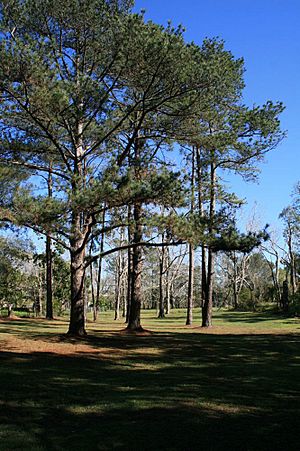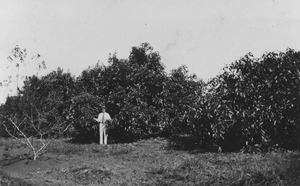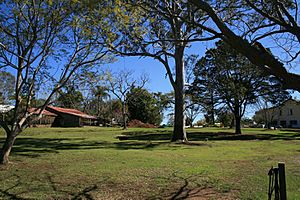Acclimatisation Society gardens, Lawnton facts for kids
Quick facts for kids Acclimatisation Society gardens, Lawnton |
|
|---|---|

Mature trees in the Acclimatisation Society gardens, 2007
|
|
| Location | Bray Road, Lawnton, Moreton Bay Region, Queensland, Australia |
| Official name: Remnants of former acclimatisation society gardens at Lawnton | |
| Type | state heritage (landscape) |
| Designated | 8 May 2009 |
| Reference no. | 602703 |
| Significant period | 1910s |
| Lua error in Module:Location_map at line 420: attempt to index field 'wikibase' (a nil value). | |
The Acclimatisation Society gardens at Lawnton are a special heritage-listed site in Queensland, Australia. Today, only a few old pecan nut trees remain from what was once a large garden. These trees are found in Stephen Lawn Park and on some nearby private properties. They show us where the Queensland Acclimatisation Society used to grow and test new plants. This society played a big role in helping Queensland's farming industry grow.
Contents
What is Acclimatisation?
In the 1800s, "acclimatisation" meant helping plants and animals get used to a new climate. It was like teaching them to live in a different part of the world. People thought that living in a new place could change species over time. In Australia, this idea was mostly about bringing new plants and animals from other countries. The goal was to see if they could grow well here.
Acclimatisation societies were set up in all Australian colonies. They were part of a global network. These groups exchanged plants and animals with places like Kew Gardens in the United Kingdom. They kept imported plants and animals in their gardens. Then, they shared them with members or released them into the wild.
History of the Gardens
The Queensland Acclimatisation Society started in 1862. Its main goal was to help Queensland's new farming industry. They brought in plants that could be useful for business. They also did experiments to see if these plants could grow in Queensland's warm climate.
Some important plants they researched included:
- Sugar cane
- Bananas
- Cotton
- Apples
- Pineapples
- Pecan nuts
- Macadamia nuts
Many of these plants later became very important crops in Queensland.
The society helped the sugar industry a lot. From 1863, they imported sugar cane from other countries. They gave it to farmers. They also researched new types of cane. They even created a popular type called Q813. This cane was good because it could resist diseases.
Before the government had a Department of Agriculture, this society gave advice on farming. They helped set up important places like the Queensland Herbarium. They also helped create the Queensland Forestry Department.
Moving to Lawnton
Between 1914 and 1915, the society moved its main gardens. They left their first home at Bowen Park. They moved to a 100-acre property in Lawnton. This new site was next to the North Pine River. The old Bowen Park site was no longer suitable. This was partly because the government supported them less. Also, the nearby National Association grounds were expanding.
At Lawnton, there was an old house by the river. It was fixed up. In 1915, a new cottage was built. This cottage had an office for the society's records. Later, more buildings were added. These included places to grow plants and a tool shed. They even planted pretty trees along the entrance road.
For about 30 years, the society kept helping Queensland's farms at Lawnton. They worked with the Department of Agriculture. They also worked with the Council for Scientific and Industrial Research (now CSIRO).
Plants they introduced and studied at Lawnton included:
- Cotton
- Castor oil plants
- Avocados
- Pecan nuts
- Citrus fruits
- Macadamia nuts
- Custard apples
- Mangoes
- Pineapples
- Soy beans
The society helped make avocados, pecan nuts, and grapefruits successful crops in Queensland. They even developed a type of avocado called 'Allsopp'. This was named after their overseer. The pecan nut grove was at the northern end of the gardens. It was still growing well when the gardens were sold.
Pecan nuts are now a commercial crop in Australia. There are many growers in Queensland and other states. The pecan trees at Lawnton are special. They are the only known trees left from the society's pre-World War II plantings. These trees are important because they show how the society helped Queensland's farming.
The society sold its Lawnton gardens between 1941 and 1942. They moved to a smaller property in Redcliffe. The land at Lawnton was becoming less fertile. After the society left, the land was used as a dairy farm. Later, in 1959, it was divided up for houses.
What Remains Today
Today, about 15 mature pecan trees (Carya sp) are left. They are from the original Acclimatisation Society plantings. These trees are along the river flats of the North Pine River. You can find them northeast of Bray Road in Lawnton. Six of these old trees are in Stephen Lawn Park. The other nine are in the backyards of houses next to the park. They are still in rows, just like they were planted. There are also some younger trees that might have grown from the original grove.
Why is it Heritage Listed?
The remnants of the former Acclimatisation Society gardens at Lawnton were added to the Queensland Heritage Register on May 8, 2009. This means they are important to Queensland's history and culture.
- Showing Queensland's History: The pecan nut trees show how people in Queensland adapted to their new environment. The Acclimatisation Society experimented with plants from other countries. They wanted to see if they could grow well in Queensland's climate. This work helped develop Queensland's farming industries. These trees are the only known ones left from the society's early work on commercial crops. They are a great example of this important historical effort.
- Rare in Queensland's Heritage: These pecan trees are very rare. They are some of the only known trees left from the Queensland Acclimatisation Society's gardens before World War II. The society focused on "economic botany," which means finding plants that could be grown for profit. Pecan nuts are now a commercial crop in Queensland. These trees are the only known plantings linked to the society's work in this area.
- Special Connection to an Important Group: The remaining pecan grove has a special link to the Queensland Acclimatisation Society. This group made a big difference in developing Queensland's farming industries. The pecan nut grove was a key part of their Lawnton gardens from 1915 to 1941.
See Also
Images for kids




